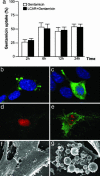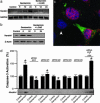Pivotal role of Harakiri in the induction and prevention of gentamicin-induced hearing loss
- PMID: 16239342
- PMCID: PMC1276101
- DOI: 10.1073/pnas.0508053102
Pivotal role of Harakiri in the induction and prevention of gentamicin-induced hearing loss
Abstract
Gentamicin is a widely used ototoxic agent. In this study, we shed light on the mechanisms underlying gentamicin-induced hearing loss. More importantly, we demonstrate in vivo and in vitro the effectiveness of a strategy for preventing drug-induced hearing loss using l-carnitine (LCAR), a safe micronutrient that plays a key role in energy metabolism and detoxification [Rebouche, C. J. & Seim, H. (1998) Annu. Rev. Nutr. 18, 39-61]. We show that LCAR prevents changes in hearing threshold and cochlear damage in newborn guinea pigs exposed to gentamicin in utero. Mechanistically, gentamicin-induced apoptosis of auditory cells is mediated by the extracellular signal-regulated kinase (ERK) 1/2 mitogen-activated protein kinase (MAPK) pathway through up-regulation of the proapoptotic factor Harakiri (Hrk). Most important, small interfering RNA (siRNA) experiments demonstrate that Hrk up-regulation is crucial for gentamicin-induced apoptosis. LCAR, in contrast, prevents both gentamicin-induced Hrk up-regulation and apoptosis acting by means of c-Jun N-terminal kinase (JNK). Together, these results outline pathways for gentamicin-induced hearing loss and its prevention and assign a key role to Hrk in these processes. Thus, our data offer a conceptual framework for designing clinical trials using a safe micronutrient, LCAR, as a simple preventive strategy for iatrogenically induced ototoxicity.
Figures




Similar articles
-
Mitochondria-targeted antioxidant MitoQ reduces gentamicin-induced ototoxicity.Otol Neurotol. 2014 Mar;35(3):533-9. doi: 10.1097/MAO.0000000000000192. Otol Neurotol. 2014. PMID: 24518411
-
Blocking c-Jun-N-terminal kinase signaling can prevent hearing loss induced by both electrode insertion trauma and neomycin ototoxicity.Hear Res. 2007 Apr;226(1-2):168-77. doi: 10.1016/j.heares.2006.09.008. Epub 2006 Nov 13. Hear Res. 2007. PMID: 17098385
-
Transient ischemia/hypoxia enhances gentamicin ototoxicity via caspase-dependent cell death pathway.Lab Invest. 2011 Jul;91(7):1092-106. doi: 10.1038/labinvest.2011.69. Epub 2011 Apr 25. Lab Invest. 2011. PMID: 21519324
-
Aspirin attenuates gentamicin ototoxicity: from the laboratory to the clinic.Hear Res. 2007 Apr;226(1-2):178-82. doi: 10.1016/j.heares.2006.05.008. Epub 2006 Jul 17. Hear Res. 2007. PMID: 16844331 Review.
-
Ototoxicity: mechanisms of cochlear impairment and its prevention.Curr Med Chem. 2011;18(31):4866-71. doi: 10.2174/092986711797535254. Curr Med Chem. 2011. PMID: 21919841 Review.
Cited by
-
Maternal exposure to polycyclic aromatic hydrocarbons diminishes murine ovarian reserve via induction of Harakiri.J Clin Invest. 2007 Dec;117(12):3971-8. doi: 10.1172/JCI28493. J Clin Invest. 2007. PMID: 18037991 Free PMC article.
-
Apoptosis in acquired and genetic hearing impairment: the programmed death of the hair cell.Hear Res. 2011 Nov;281(1-2):18-27. doi: 10.1016/j.heares.2011.07.002. Epub 2011 Jul 18. Hear Res. 2011. PMID: 21782914 Free PMC article. Review.
-
Intracellular mechanisms of aminoglycoside-induced cytotoxicity.Integr Biol (Camb). 2011 Sep;3(9):879-86. doi: 10.1039/c1ib00034a. Epub 2011 Jul 29. Integr Biol (Camb). 2011. PMID: 21799993 Free PMC article. Review.
-
NLRX1 accelerates cisplatin-induced ototoxity in HEI-OC1 cells via promoting generation of ROS and activation of JNK signaling pathway.Sci Rep. 2017 Mar 13;7:44311. doi: 10.1038/srep44311. Sci Rep. 2017. PMID: 28287190 Free PMC article.
-
L-Carnitine Attenuates Cardiac Dysfunction by Ischemic Insults Through Akt Signaling Pathway.Toxicol Sci. 2017 Dec 1;160(2):341-350. doi: 10.1093/toxsci/kfx193. Toxicol Sci. 2017. PMID: 28973678 Free PMC article.
References
-
- Chambers, H. F. & Sande, M. A. (1996) in Goodman & Gilman's The Pharmacological Basis of Therapeutics, eds. Hardman, J. G., Limbird, L. E., Molinoff, P. B., Ruddon, R. W. & Gilman, A. G. (McGraw-Hill, New York), pp. 1103-1121.
-
- Romero, R., Espinoza, J., Chaiworapongsa, T. & Kalache, K. (2002) Semin. Neonatol. 7, 259-274. - PubMed
-
- Henley, C. M. & Rybak, L. P. (1995) Brain Res. Brain Res. Rev. 20, 68-90. - PubMed
-
- Priuska, E. M. & Schacht, J. (1995) Biochem. Pharmacol. 50, 1749-1752. - PubMed
-
- Forge, A. & Schacht, J. (2000) Audiol. Neurootol. 5, 3-22. - PubMed
Publication types
MeSH terms
Substances
Grants and funding
LinkOut - more resources
Full Text Sources
Research Materials
Miscellaneous

